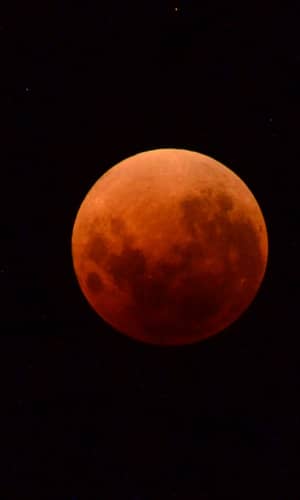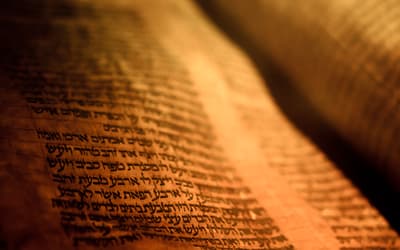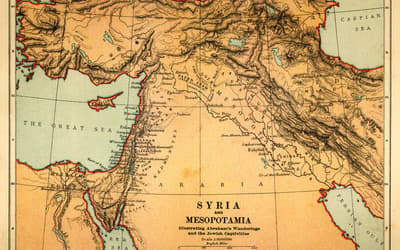The views expressed in this paper are those of the writer(s) and are not necessarily those of the ARJ Editor or Answers in Genesis.
Abstract
Joel’s prophecy that the moon will be turned to blood appears in a list of portents (3:3–4 Heb.; 2:30–31 Eng.). Scholarly interpretations of this lunar phenomenon usually explain it as a discoloration caused by either voluminous smoke and dust or a lunar eclipse. An examination of the word מוֹפְתִים (“portents”), however, indicates that the celestial transformation requires something more dramatic. This article argues that a theory by astronomer Danny Faulkner makes better sense of the event and the context of Joel than extant theories. Faulkner posits that Joel described a dried-blood color lunar eclipse. Historical and scientific research explains that dark-brown lunar eclipses were considered omens of famine and unrest. Furthermore, an especially dark lunar eclipse fits the parallel passages in Joel 2:10 and 4:15 Heb.; 3:15 Eng. as well as the context of temple sacrifice found in the book.
Keywords: Joel, portents, parallelism, lunar eclipse, blood moon, temple sacrifice
Introduction
The book of Joel contains three prophecies of moon discoloration. In Joel 2:10 and 3:15 [4:15 Heb.], both sun and moon are darkened [קָדָרוּ].1 Sandwiched between the dark moon prophecies is a statement that the sun will be turned to darkness [הַשֶּׁמֶשׁ יֵהָפֵךְ לְחֹשֶׁךְ] and the moon to blood [וְהַיָּרֵחַ לְדָם] (3:4 Heb.; 2:31 Eng.).2 Scholars have explained these celestial phenomena in a number of ways. A few contend that Joel 2:31 refers to a lunar eclipse.3 The dominant theory, however, argues that Joel’s lunar discoloration arises from, “an atmospheric abnormality resulting from raging fires” and this “probably provides the imagery for the moon’s strange appearance . . . . The reference to the moon’s color may even derive from extraordinary sandstorms that give the moon a reddish appearance” (Crenshaw 1995, 168).4 Both the traditional lunar eclipse theory and the smoke hypothesis, however, fail to explain why Joel labels the moon’s appearance in a list of “portents” [מוֹפְתִים] (3:3 Heb.; 2:30 Eng.). For the lunar sign to meet this standard, it must change in a way that the observers would interpret as an act of God. This article argues that a theory from astronomer Danny Faulkner offers a superior explanation for how Joel’s moon prophecy qualifies as a “portent” (Faulkner 2016, 170–178; Faulkner pers. comm.) Faulkner believes that color of the moon in Joel 2:10, 2:31, and 3:15 is a dark brown likened to that of dried blood. Dark-brown lunar eclipses have occurred rarely in history and ancient peoples believed they portended dire events.
Parallelism and Portents
The three moon prophecies in Joel share similar syntax with different emphases. These linguistic links suggest textual interplay. The correspondence between 2:10 and 3:15 is plain. Both verses contain the identical Hebrew sentence שֶׁמֶשׁ וְיָרֵחַ קָדָרוּ וְכוֹכָבִים אָסְפוּ נָגְהָם (“the sun and moon are darkened and the stars withdraw their brightness”). Interplay also exists between 2:10–11 and 2:31 as, “Both 2:10 and 3:4a–b [2:31 Eng.] announce that the heavenly bodies will grow dark in anticipation of the day of YHWH. Joel emphasizes the parallel between 2:11 and 3:4c, in both cases referring to the day of YHWH as הַגָּדוֹל וְהַנּוֹרָא” (Barker 2020, 140). The similarity in theme and phrasing between these passages suggests that Joel uses poetic repetition to describe the same events from different perspectives. By this logic, the darkened moons in 2:10 and 3:15 describe the same event as the blood moon in 2:31. Of course, a bright-red moon would appear darker than a normal moon, yet bright red is not the image conjured in 2:10 and 3:15. For this reason, the idea of a dried-blood moon better coheres with a harmonization of the poetic images and provides a more potent image of judgment than merely calling it brown.
While the above argument seems reasonable enough, the text provides a more concrete reason to adopt Faulkner’s thesis. Joel 2:30–31 reads,
I will set מוֹפְתִים in the heavens and in the earth,
blood and fire and columns of smoke.
The sun will be turned into darkness
and the moon into blood,
before the great and fearful day of the Lord comes.
According to Koehler, Baumgartner, and Stamm (1999), the root מוֹפֵת can mean “wonder,” “sign,” or “portent.” Hans Wolff adds nuance to interpreting the noun, “While אוֹת (‘sign’) need not indicate anything extraordinary, and פֶלֶא (‘extraordinary thing’) need not refer to a sign; מוֹפֵת is that which is completely out of the ordinary and as such has sign character” (Wolff 1977, 67–68). Similarly, John Barton states,
A môpēt is an event or object that points beyond itself to some remarkable divine intervention. Thus Isaiah and his prophetically named children are described as môpĕtîm in Isa 8:18, and Isaiah himself is a môpēt when he walks around Jerusalem naked and barefoot in Isa 20:3, prefiguring the suffering of its people. The plagues of Egypt are also môpĕtîm in Pss. 78:43; 105:5, 27; and 135:9, perhaps because they are forerunners of the great divine act in the exodus. The English word portent in fact is a very adequate rendering. (Barton 2001, 97)
As Wolff and Barton show, Joel’s “blood moon” requires an event particularly rare and arresting.
This conclusion is supported by examining the other 35 times the root מוֹפֵת appears in the Old Testament. Seventeen refer to the miraculous events of Israel’s Exodus deliverance.5 Another nine references pertain to dramatic miracles.6 In one case, it refers to extraordinary curses coming upon God’s people.7 In the final eight instances, God makes a person into a wonder.8
Since Joel labels both the celestial changes as well as the blood and fire and columns of smoke as מוֹפְתִים, the passage must refer to more than the typical divine judgment by invasion. To reiterate Wolff and Barton, Joel 2:30–31 portrays events that are “completely out of the ordinary” (Wolff 1977, 68) and a “remarkable divine intervention” (Barton 2001, 97). Neither smoke from fires nor dust storms from armies merit the term. Likewise, normal total lunar eclipses, which happen about once a year, cannot qualify either. Therefore, a satisfactory explanation must be something rare that would have been viewed as a divine action and a sign of coming woe.
Lunar Eclipse Colors
Before delving deeper into prophetic interpretation, a scientific explanation for the various hues lunar eclipses may present is needed. Richard Strothers explains that “When totally eclipsed on a clear night, the Moon does not wholly vanish, but only dims and reddens. Exactly four centuries ago, Kepler (1604) became the first author to realize that rays of sunlight passing through the Earth’s atmosphere are refracted (and scattered) into the shadow cone, illuminating the Moon’s face” (Strothers 2004, 886).
While astronomical precision makes it possible to know the timing of ancient lunar eclipses, it is not possible to know their color absent historical testimony since atmospheric conditions change the optics. Richard Keen explains:
Rays of sunlight passing between 5 and 25 km above the earth’s surface are most effective at illuminating the eclipsed moon. The brightness of the moon will be affected by the refractive properties of this layer, the presence of absorbing media such as clouds, ozone, and aerosols in and above the layer, and the position of the moon within the shadow. Large differences in brightness between eclipses have been noted for centuries. (Keen 1983, 1011)
In 1921, astronomer Andre-Louis Danjon published a color scale to compare the color differences between lunar eclipses (Danjon 1921, 261–265). It has since become the international standard to, “quantify the Moon’s appearance during totality from one total eclipse to the next (and even at different times during the same eclipse)” (Cudnik 2023, n.p.) Since Danjon’s scale sheds light on the current discussion, it is worth replicating in full here:
L = 0 Very dark eclipse. Moon is almost invisible, especially at mid-totality.
L = 1 Dark eclipse, grey or brownish colouration. Details are distinguishable with difficulty.
L = 2 Deep red or rust coloured eclipse, with a very dark central part in the umbra, and the outer rim of the umbra is relatively bright.
L = 3 Brick-red eclipse, usually with a bright or yellow rim to the umbra.
L = 4 Very bright copper-red or orange eclipse, with a bluish, very bright rim to the umbra. (Cooper 2001, 34)
Brighter eclipses are significantly more common, but abnormal amounts of atmospheric particles do produce dark eclipses.
When ancient accounts of lunar eclipses are examined, it becomes apparent that these were viewed as negative omens. For instance, one Assyrian record from Esarhaddon’s reign (680–669 BC) reads,
[If] there is an eclipse in Sivan (III) on the 14th day, and the (moon) god in his eclipse becomes dark on the east side above, and clears on the west side below, the north wind rises during the evening (!) watch and touches the middle watch: you observe his eclipse and keep the north wind in mind; thereby a decision is given for Ur and the king of Ur: the king of Ur will experience famine; deaths will become many; as for the king of Ur, his son will wrong him, but Šamaš will catch the son who wronged his father; a son of the king who had not been named for kingship will seize the throne. (Hunger 1992; brackets and parentheses original)
One of the best-known dark eclipses of the past happened in AD 1110 and is recorded in the Anglo-Saxon Chronicle:
On the fifth night of the month of May the moon appeared shining brightly in the evening, and afterwards his light waned by little and little, and early in the night he was so wholly gone that neither light, nor circle, nor any thing at all of him was to be seen, and thus it continued till near day, and then he appeared shining full and bright; he was a fortnight old the same day: the sky was very clear all the night, and the stars shone very brightly all over the heavens. (Giles 1914, 181)
This lunar eclipse has been linked to, “several closely spaced volcanic eruptions that occurred between 1108 and 1110” (Guillet et al. 2020, 1). The fact that ancient peoples saw dark lunar eclipses as evil omens is now understood more scientifically as modern researchers have also been able to link massive volcanic eruptions to crop failures and famines. “Modeling and observational studies find a global decrease in precipitation in the immediate years following volcanic events . . . . The decrease in global precipitation is likely caused by the reduction of incident shortwave radiation at the surface due to stratospheric volcanic aerosols, suppressing evaporation and leading to a cooler and more stable troposphere” (Rao et al. 2017, 5104). Scientists studying the 1110 eclipse, “identified 13 narrative sources that describe meteorological phenomena and conditions in the years 1109–1111 CE. Despite the more limited frequency of meteorological entries at the beginning of the 12th century,” the study reveals an “abundance of testimonies referring to adverse weather, crop failures, and famines in these years” (Guillet 2020, 5). While massive eruptions did not necessarily lead to starvation, historical evidence shows that the reduced crop production often results in hoarding and price gouging (Slavin 2016, 433–447). This combination of factors has often resulted in, “famines, wars and threats to states and regimes” (Hao et al. 2020, 1). The similarities between these findings and the previous citation from an Assyrian omen text are striking.
Dried Blood
Faulkner notes that in Revelation 16:3 an angel pours out a bowl of wrath on the earth that causes the sea to become “as the blood of a dead man” (αἷμα ὡς νεκροῦ) (Faulkner 2016, 171).9 While Revelation 16 is not referencing Joel, it does show a correspondence between judgment and dried blood. Furthermore, Faulkner sees the prominence Joel places on temple activity as support for his thesis. Each large animal sacrificed in the temple represented gallons of spilled blood. Paul Johnson’s vivid words help here, “nothing could hide the essential business of the Temple, which was the ritual slaughter, consumption and combustion of sacrificial cattle on a gigantic scale. The place was as vast as a small city” (Johnson 1979, 13–14).10 Johnson continues by explaining that the temple visitor would have been immediately struck by, “the smoke of the pyres, the bellows of terrified beasts, the sluices of blood, the abattoir stench” (Johnson 1979, 13–14). Faulkner deduces that since Joel’s context includes temple worship, the original audience would have interpreted 2:31 as depicting coagulated blood (Faulkner pers. comm.). When the contexts of Joel 2:10 and 3:15 are considered, the argument strengthens. In 2:10, 2:31, and 3:15 the sun is darkened, whereas the text mentions the moon darkening in 2:10 and 3:15. It is reasonable to conclude that Joel’s “blood” moon in 2:31 functions as both an ominous portent and as a poetic macro-parallelism—in each case the moon is darkened, but the imagery of blood avoids a threefold repetition of darkening while evoking a recognized portent in the context of a life spilled out.
Conclusion
This article has argued that the predominant explanations of Joel’s “blood moon” in 2:31 fail to satisfy the prophet’s requirement that the event qualify as a portent. Neither the smoke theory nor the traditional lunar eclipse theory fits the qualifications of a מוֹפֵת as both possibilities produce moon discolorations that the observers would have considered natural. Likewise, normal lunar eclipses occur frequently enough that they would have been considered a “sign” but not a “portent.” In contrast, Faulkner better explains Joel’s context. Most importantly, dark-brown lunar eclipses were viewed by ancients as evil omens and occurred infrequently while orangish-red eclipses were not exceptional. Scientists have discovered that especially dark lunar eclipses often did portend coming famine, societal unrest, and political upheaval. Also, to an audience familiar with the death of sacrificial animals and the dried blood that remained, such a sight would understandably be seen as a serious divine message. Lastly, linguistic similarities between the three moon passages suggest a poetic parallelism between the dark moons in 2:10 and 3:15 and the blood moon of 2:31. While impossible to prove, Faulkner’s hypothesis explains how the event qualified as a portent and deserves scholarly consideration.
References
Achtemeier, Elizabeth. 1994. Joel. New Interpreter’s Bible. Nashville, Tennessee: Abingdon.
Allen, Leslie C. 1976. The Books of Joel, Obadiah, Jonah and Micah. New International Commentary on the Old Testament. Grand Rapids, Michigan: Eerdmans.
Barton, John. 2001. Joel and Obadiah: A Commentary. The Old Testament Library. Louisville, Kentucky: Westminster John Knox.
Barker, Joel. 2020. Joel: Despair and Deliverance in the Day of the Lord. Zondervan Exegetical Commentary on the Old Testament. Grand Rapids, Michigan: Zondervan Academic.
Cooper, Tim. P. 2001. “The Total Lunar Eclipse of 2001 January 9.” Monthly Notes of the Astronomical Society of South Africa 60 (April): 32–36.
Crenshaw, James L. 1995. Joel. The Anchor Yale Bible Commentary. New York, New York: Doubleday.
Cudnik, Brian. 2023. “Eclipse, Lunar.” In Encyclopedia of Lunar Science. Edited by Brian Cudnik. Cham, Switzerland: Springer International Publishing.
Danjon, Andre-Louis. 1921. “Relation Entre l’Eclairement de la Lune Eclipsee et l’Activite Solaire.” L’Astronomie 35: 261–265.
Faulkner, Danny R. 2016. The Created Cosmos: What the Bible Reveals About Astronomy. Green Forest, Arkansas: Master Books.
Giles, J. A. ed. 1914. The Anglo-Saxon Chronicle. London, United Kingdom: G. Bell and Sons.
Guillet, Sébastien, Chrisophe Corona, Francis Ludlow, Clive Oppenheimer, and Markus Stoffel. 2020. “Climatic and Societal Impacts of a ‘Forgotten’ Cluster of Volcanic Eruptions in 1108–1110 CE.” Scientific Reports 10: Article no. 6715.
Hao, Zhixin, Danyang Xiong, Jingyun Zheng, Liang Emlyn Yang, and Quansheng Ge. 2020. “Volcanic Eruptions, Successive Poor Harvests and Social Resilience over Southwest China During the 18–19th Century.” Environmental Research Letters 15, no. 10: Article number 105011.
Humphreys, Colin J., and W. G. Waddington. 1992. “The Jewish Calendar, a Lunar Eclipse and the Date of Christ’s Crucifixion.” Tyndale Bulletin 43, no. 2: 331–351.
Hunger, Hermann. 1992. Astrological Reports to Assyrian Kings. State Archives of Assyria. Vol. 8. Helsinki, Finland: Helsinki University Press.
Johnson, Paul. 1979. A History of Christianity. New York, New York: Simon and Schuster.
Keen, Richard A. 1983. “Volcanic Aerosols and Lunar Eclipses.” Science 222, no. 4627 (2 December): 1011–1013.
Koehler, Ludwig, Walter Baumgartner, and Johan J. Stamm. 1999. The Hebrew and Aramaic Lexicon of the Old Testament. Translated and edited under the supervision of Mervyn E. J. Richardson. 4 vols. Leiden: Brill. 1999.
Meier, Ernst Heinrich. 1841. Der Prophet Joel. Tübingen, Germany: Ludwig Friedrich Fues.
Rao, M. P., B. I. Cook, E. R. Cook, R. D. D’Arrigo, P. J. Krusic, K. J. Anchukaitis, A. N. LeGrande, B. M. Buckley, N. K. Davi, C. Leland, and K. L. Griffin. 2017. “European and Mediterranean Hydroclimate Responses to Tropical Volcanic Forcing Over the Last Millennium.” Geophysical Research Letters 44, no. 10 (28 May): 5104–5112.
Slavin, Philip. 2016. “Climate and Famines: A Historical Reassessment.” WIRES Climate Change 7, no. 3 (May/June): 433–447.
Stephenson, F. R. 1969. “The Date of the Book of Joel.” Vetus Testamentum 19, no. 2 (1 January): 224–229.
Strothers, Richard B. 2004. “Stratospheric Transparency Derived from Total Lunar Eclipse Colors, 1665–1800.” The Publications of the Astronomical Society of the Pacific 116, no. 823 (September): 886–893.
Wolff, Hans Walter. 1977. Joel and Amos. Translated by Waldemar Janzen. Philadelphia, Pennsylvania: Fortress Press.






